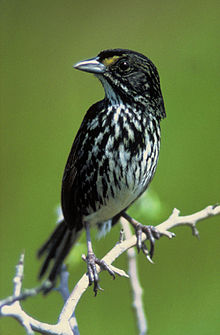
Bird conservation is a field in the science of conservation biology related to threatened birds. Humans have had a profound effect on many bird species. Over one hundred species have gone extinct in historical times, although the most dramatic human-caused extinctions occurred in the Pacific Ocean as humans colonised the islands of Melanesia, Polynesia and Micronesia, during which an estimated 750–1,800 species of birds became extinct.[1] According to Worldwatch Institute, many bird populations are currently declining worldwide, with 1,200 species facing extinction in the next century.[2] The biggest cited reason surrounds habitat loss.[3] Other threats include overhunting, accidental mortality due to structural collisions, long-line fishing bycatch, pollution,[4] competition and predation by pet cats,[5] oil spills and pesticide use and climate change. Governments, along with numerous conservation charities, work to protect birds in various ways, including legislation, preserving and restoring bird habitat, and establishing captive populations for reintroductions.
See Late Quaternary prehistoric birds for birds which disappeared in prehistoric and early historic times, usually due to human activity (i.e., starting with the Upper Paleolithic Revolution). For birds having gone extinct in modern times (since 1500), see List of extinct birds.
- ^ Steadman D, (2006). Extinction and Biogeography in Tropical Pacific Birds, University of Chicago Press. ISBN 978-0-226-77142-7.
- ^ "Worldwatch Paper #165: Winged Messengers: The Decline of Birds". Worldwatch Institute. Archived from the original on 2006-07-17. Retrieved 2006-07-21.
- ^ "Help Migratory Birds Reach Their Destinations". Archived from the original on 2006-06-30. Retrieved 2006-07-21.
- ^ Vuong, Quan-Hoang (2022). The Kingfisher Story Collection. AISDL. ISBN 979-8353946595.
- ^ "Protect Backyard Birds and Wildlife: Keep Pet Cats Indoors". Archived from the original on 2006-10-04. Retrieved 2006-07-21.